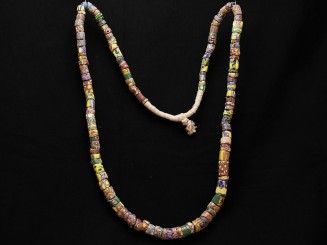Strand Venetian Millefiori old trade beads
Mali
Lenght: 106 cm
Height: 53 cm
Units: 103
A superb strand of one hundred and thirty mixed old Murano glass beads, among them, the so-called millefiori (lit. thousand flowers) and mosaic. European glass trade beads became extremely popular in Africa. They were commonly used in barter transactions in exchange for a wide range of commodities from ivory or palm oil to gold. Venetian glass trade beads were among the most reputed ones both for the mastery in their manufacture as well as for the nearly endless combination of designs and colors. About the end of the XVth century most of the production of Venetian glass beads moved to the island of Murano were the drawn technique was recovered so that boosting the production as compared to the slower wound technique. Some other techniques were also used: molded, blown, wound-on-drawn. Some chips and dents commensurate with age. A beautiful combination of trade beads.
"Millefiori" beads, literally "thousand flowers", are probably the most popular of all trade beads manufactured in Europe and used in the colonial commerce from the 18th to mid 20th century. Its production was recovered in Venice in the 16th century from models as old as those manufactured in Asia in the first millennium BC, or in Egypt during the Roman period between the first and fourth centuries and later by those made in the Middle East which spread during the expansion of Islam between the 8th and 12th centuries.
We use the term trade beads to refer to the European made glass beads that were used by the European merchants and explorers in the trade in Africa as from the 15th century and continued during their colonial expansion.
The history of trade beads in Africa takes us then to the 15th century and the arrival of the Euro-pean, mainly the Portuguese, to the coasts of West Africa. The European discovered quite soon how much the people they met there fancied beads and saw they an opportunity for trade. Amongst the beads that captivated the African people most were glass beads since the techniques for their making had not yet been developed locally. The locals fell for the precious and colorful glass beads such as Venetian millefiori or chevron beads that the European traders had on offer and bartered them for commodities such as precious woods, ivory, gold and even used, ignomi-niously, in the slave trade. The increasing demand in Africa of European made glass beads conti-nued quite until the first half of the 20th century and it had a boosting effect in the production in cities such as Venice which glass beads became very popular and coveted.



